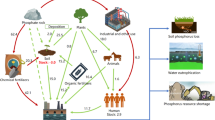Abstract
Rates of biosorption of cadmium and copper ions by nonliving biomass of the brown macroalga Sargassum sinicola under saline conditions were studied. Batch experiments show that the ability to remove cadmium is significantly diminished (from 81.8% to 5.8%), while the ability to remove copper remains high (from 89% to 80%) at a range of salinity from 0 to 40 psu. Maximum capacity of biosorption at 35 psu was 3.44 mg g−1 for cadmium and 116 mg g−1 for copper. The presence of salt did not significantly affect the rate of biosorption, which was about 90% of saturation in 60 min for both metals. There is an antagonistic effect on biosorption when both metals are present in the solution.




Similar content being viewed by others
References
Antunes, W. M., Luna, A. S., Henriques, C. A., & Costa, A. C. (2003). An evaluation of copper biosorption by brown seaweed under optimized conditions. Electronic Journal of Biotechnology. http://www.scielo.cl/scielo.php?script=sci_arttext&pid=S0717-34582003000300003&lng=es&nrm=iso. Accessed 3 Jun 2009
Brierley, J. A., Goyak, G. M., & Brierley, C. L. (1986). Considerations for commercial use of natural products for metals recovery. In H. Eccles & S. Hunt (Eds.), Immobilization of ions by biosorption (pp. 105–117). Chichester: Ellis Horwood.
Cañizares-Villanueva, R. O. (2000). Biosorción de metales pesados mediante el uso de biomasa microbiana. Revista Latinoamericana de Microbiología, 42, 131–141.
Casas-Valdez, M. (2009). El alga marina Sargassum (Sargassaceae) en el desarrollo regional. In: J. Urciaga-García, D. Lluch-Belda, L. F. Beltrán-Morales (Eds.), Recursos marinos y servicios ambientales en el desarrollo regional (pp. 139–156). La Paz, México: CIBNOR.
Davis, T. A., Volesky, B., & Vieira, R. H. S. F. (2000). Sargassum seaweed as biosorbent for heavy metals. Water Research, 34, 4270–4278.
Dönmez, G., & Aksu, Z. (2002). Removal of chromium (VI) from saline wastewaters by Dunaliella species. Process Biochemistry, 38, 751–762.
Gadd, G. M. (2008). Biosorption: critical review of scientific rationale, environmental importance and significance for pollution treatment. Journal of Chemical Technology and Biotechnology, 84, 13–28.
Holan, Z. R., Volesky, B., & Prasetyo, I. (1993). Biosorption of Cd by biomass of marine algae. Biotechnology and Bioengineering, 41, 819–825.
Huerta-Diaz, M. A., De León-Chavira, F., Lares, M. L., Chee-Barragán, A., & Siqueiros-Valencia, A. (2007). Iron, manganese and trace metal concentrations in seaweeds from the central west coast of the Gulf of California. Applied Geochemistry, 22, 1380–1392.
Kaewsarn, P. (2002). Biosorption of copper (II) from aqueous solutions by pre-treated biomass of marine algae Padina sp. Chemosphere, 47, 1081–1085.
Kratochivil, D., & Volesky, B. (1998). Biosorption of Cu from ferruginous wastewater by algal biomass. Water Research, 32, 2760–2768.
Lodeiro, P., Cordero, B., Grille, Z., Herrero, R., & Sastre de Vicente, M. E. (2004). Physicochemical studies of cadmium (II) biosorption by the invasive alga in Europe, Sargassum muticum. Biotechnology and Bioengineering, 88, 237–247.
Méndez, L., Palacios, E., Acosta, B., Monsalvo-Spencer, P., & Alvarez-Castañeda, T. (2006). Heavy metals in the clam Megapitaria squalida collected from wild and phosphorite mine-impacted sites in Baja California, Mexico. Biological Trace Element Research, 110, 275–287.
Pivovarov, S. (2003). Physico-chemical modeling of heavy metals (zinc, cadmium, copper) in natural environments. In A. Hubbard & P. Somasundaran (Eds.), Encyclopedia of surface and colloid science. New York: Marcel Dekker.
Rodríguez-Figueroa, G. M., Shumilin, E., & Sanchez-Rodriguez, I. (2008). Heavy metal pollution monitoring using the brown seaweed Padina durvillaei in the coastal zone of the Santa Rosalía mining region, Baja California Peninsula, Mexico. Journal of Applied Phycology, 21, 19–26.
Sánchez-Rodríguez, I., Huerta-Diaz, M. A., Choumiline, E., Holguín-Quiñones, O., & Zertuche-González, J. A. (2001). Elemental concentrations in different species of seaweed from Loreto bay (Baja California del Sur), Mexico. Implications for the geochemical control of metals in algal tissues. Environmental Pollution, 114, 145–160.
Schiewer, S., & Volesky, B. (1999). Advances in biosorption of heavy metals. In M. C. Flickinger & S. W. Drew (Eds.), Encyclopedia of bioprocess engineering (pp. 433–453). New York: Wiley.
Sheng, P. X., Ting, Y. P., Chen, J. P., & Hong, L. (2004). Sorption of lead, copper, cadmium, zinc, and nickle by marine algal biomass: characterization of biosorptive capacity and investigation of mechanisms. Journal Colloid and Interface Science, 275, 131–141.
Sheng, P. X., Ting, Y. P., & Chen, J. P. (2007). Biosorption of heavy metal ions (Pb, Cu, and Cd) from aqueous solutions by the marine alga Sargassum sp. in single and multiple-metal systems. Industrial & Engineering Chemistry Research, 46, 2438–2444.
Shumilin, E. N., Rodríguez-Figueroa, G., Morton-Bermea, O., Lounejeva-Baturina, E., Hernández, E., & Rodríguez-Meza, G. D. (2000). Anomalous trace element composition of coastal sediments near the copper mining district of Santa Rosalia, Peninsula of Baja California, Mexico. Bulletin Environmental Contamination and Toxicology, 65, 261–268.
Stirk, W. A., & Van Staden, J. (2000). Removal of heavy metals from solution using dried brown seaweed material. Botanica Marina, 43, 467–473.
Volesky, B., & Holan, Z. R. (1995). Biosorption of heavy metals. Biotechnology Progress, 11, 235–250.
Volesky, B., Weber, J., & Vieira, R. (1999). Biosorption of Cd and Cu by different types of Sargassum biomass. Process Metallurgy, 9, 473–482.
Yun, Y. S., Niu, H., & Volesky, B. (2001). The effect of impurities on metal biosorption. International Biohydrometallurgy Symposium, Brazil, pp. 181–187.
Zhou, J. L., Huang, P. L., & Lin, R. G. (1998). Sorption and desorption of Cu and Cd by macroalgae and microalgae. Environmental Pollution, 101, 67–75.
Acknowledgments
We thank Griselda Peña Armenta at CIBNOR for laboratory assistance and Ira Fogel and Diana Fischer for editorial improvements. This research was supported by Centro de Investigaciones Biológicas del Noroeste (project grant PC 2.1). Mónica Patrón-Prado received a doctoral grant fellowship from CONACYT of Mexico.
Author information
Authors and Affiliations
Corresponding author
Rights and permissions
About this article
Cite this article
Patrón-Prado, M., Acosta-Vargas, B., Serviere-Zaragoza, E. et al. Copper and Cadmium Biosorption by Dried Seaweed Sargassum sinicola in Saline Wastewater. Water Air Soil Pollut 210, 197–202 (2010). https://doi.org/10.1007/s11270-009-0241-3
Received:
Accepted:
Published:
Issue Date:
DOI: https://doi.org/10.1007/s11270-009-0241-3




